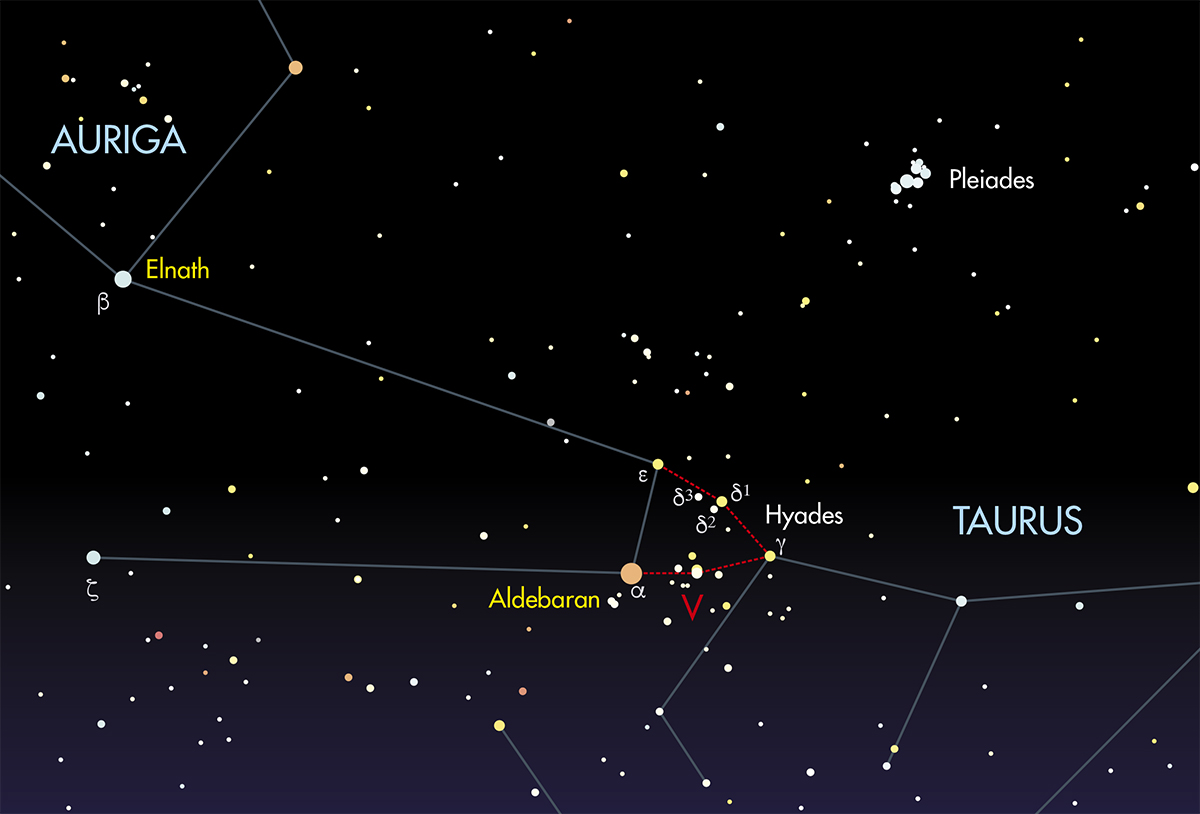Spot 144P/Kushida pass through the famous star cluster in Taurus as the comet makes its seven-yearly visit.
Comet 144P/Kushida is well placed for Northern Hemisphere viewing in early 2024, with the best time to see it being 1–18 and 28 January into early February.
The comet is ninth-magnitude in February, making it a good target for a small telescope or larger-format binoculars, and as a special treat will pass by the Hyades star cluster.
Comet 144P/Kushida is especially well placed for Northern Hemisphere observation and is easy to locate for the first third of February as it passes through Taurus.
Find out what comets and asteroids are in the sky tonight and discover the brightest comets to see in 2024
Comet 144P/Kushida in February
On the night of 1/2 February, 144P/Kushida is located 2.5° west of mag. 3.7 Gamma (γ) Tauri, the star at the pointed end of the ‘V’ shape formed by the main stars in the Hyades.
The Hyades represents the face of Taurus the Bull, Gamma Tauri marking the position of the Bull’s nose.
This position also places the comet just shy of 10° southeast of Alcyone (Eta (η) Tauri), which is at the heart of the Pleiades open cluster.

As a consequence, a wide-angle photograph that contains both clusters will also contain the comet.
On 1 February, 144P/Kushida is expected to shine with an integrated magnitude of 9.1, its brightest for the month.
By the end of February it’s expected to have faded to mag. 9.9, which is still pretty decent and well within small telescope range.
In the days after 1 February, the comet approaches Gamma Tauri, passing 0.3° north of the star on 4/5 February. It then trundles along the southern arm of the Hyades ‘V’ shape, passing 13 arcminutes north of Theta1 (θ1) Tauri, the northernmost star of naked-eye double Theta (θ) Tauri, on the night of 7/8 February.

On the nights of 9/10 and 10/11 February, 144P/Kushida passes very close to mag. 0.9 Aldebaran (Alpha (α) Tauri).
The comet is predicted to be around mag. 9.3 at this time, and if it shows the characteristic green coma colour often seen with comets, this should provide good colour contrast with the striking orange hue of Aldebaran.
The closest approach to Aldebaran occurs around 15:00 UT on 10 February, when the comet misses the star by just 8 arcminutes.

During this period, the Moon will be conveniently out of the way, only making its presence known on 13–26 February.
Consequently, 144P/Kushida’s best visibility in terms of sky darkness occurs in the first half of February when the comet is expected to be at its brightest for the month.
Throughout the remainder of February, 144P/Kushida tracks along a path that takes it more or less parallel to the southern boundary between Taurus and Orion.

Comet 144P/Kushida in January
The comet passes along a track from southern Aries at the start of January towards the Hyades in Taurus by the end.
On 1 January, 144P/Kushida sits 2° to the south of mag. 5.8 Uranus, a situation that provides a good navigational guide for finding the comet.
Over the following days, 144P/Kushida heads east, passing 5° north of the pair of stars Xi (ξ) and Omicron (ο) Tauri on 11–14 January.
On 11 January Comet Kushida crosses from Aries into Taurus, then heads directly for the point of the V-shaped Hyades open cluster, marked by Gamma (γ) Tauri.

From 21 to 31 January, 144P/Kushida passes 9° south of the Pleiades open cluster as it approaches the Hyades.
A wide-angle photo of the region will prove interesting, especially if you record the comet over several days and combine the images to show how it moves through the scene.
For more advice, read our guide on how to photograph a comet.
The next perihelion date for 144P/Kushida will be on 25 January 2024, when it is expected to brighten to around ninth magnitude.

Comet Kushida and the Moon
The enemy of diffuse objects like comets is the natural light pollution created by the Moon.
The first new Moon of 2024 occurs on 11 January.
Viewing from early evening 1 January until 18 January will give you dark, moonless skies in which to enjoy the Comet 144P/Kushida.
The Moon then causes a nuisance as it passes through the region where the comet is located, its full phase occurring on 25 January.
Consequently, the period from 19 to 27 January will be problematic in terms of observing comet Kushida.
From 28 January into early February, early evening dark skies will once again form an excellent window through which to view 144P/Kushida.
Facts about Comet Kushida
Comet 144P/Kushida was discovered by Yoshio Kushida at the Yatsugatake South Base Observatory on 8 January 1994.
It was the first comet discovery of 1994 and the second comet discovery by Kushida in the space of one month.
It was recorded on film using a 100mm f/4.0 telescope.
Initial observations were used by Japanese astronomer Shuichi Nakano to compute an orbit which showed a perihelion on 5 December 1993, when the comet passed 1.36 AU from the Sun.
A low inclination orbit of 4.11° to the plane of the Solar System suggested it was a short-period comet.
It’s now known to have a 7.37-year orbit.
As its prefix identifier suggests, it was the 144th comet to have its periodic orbit determined.
At aphelion, 144P/Kushida moves to a position beyond the orbit of Jupiter, 6.28 AU from the Sun.
This distance indicates that this comet belongs to the Jupiter family of comets.
This is a family of comets that exhibit orbits with less than 20-year periods, have low orbital inclinations and are influenced by the gravity of Jupiter.
Around 800 such comets are known.
Have you managed to observe or photograph Comet 144P/Kushida? Let us know by emailing contactus@skyatnightmagazine.com.